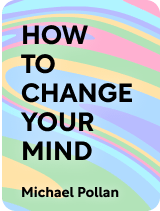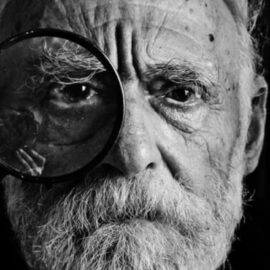

This article is an excerpt from the Shortform book guide to "How to Change Your Mind" by Michael Pollan. Shortform has the world's best summaries and analyses of books you should be reading.
Like this article? Sign up for a free trial here.
Can psychedelics really treat mental health problems? How do psychedelics affect the human brain? In what ways do psychedelics have the potential to fix society?
In How to Change Your Mind, Michael Pollan shows his research on psychedelic trials and their impact on society. He also explores the history of psychedelics from the prehistoric period until now.
Read below for a brief overview of How to Change Your Mind by Michael Pollan.
How to Change Your Mind by Michael Pollan
In How to Change Your Mind, Michael Pollan explores the potential of psychedelics for mental health treatment and discusses the cultural and social implications of these substances. He traces their history, from their use by indigenous cultures for spiritual and healing purposes to their prohibition by the US government in 1970. Pollan focuses most of his attention on two specific psychedelics—LSD and psilocybin, also known as “acid” and “magic mushrooms,” since these two substances have had the biggest impact on modern Western culture.
After exploring the complex and troubled history of these substances, Pollan examines the recent resurgence of scientific interest in psychedelics, as researchers have begun to explore their potential to treat depression, addiction, and other mental health issues. He also delves into the complex legal and cultural issues surrounding psychedelics and considers what their re-emergence might mean for our society as a whole.
Part 1: The History of Psychedelics
First, we’ll begin with a definition and brief history of psychedelics. The word “psychedelic” means “mind manifesting.” Coined in 1957, it’s a relatively recent term, but humans’ relationship with these substances is hardly new. Psychedelics are sometimes referred to by anthropologists as entheogens, which is derived from the Greek “god within,” and they are also commonly called “hallucinogens.” Pollan explains that anthropologists and other scholars generally shun the latter term, however, because of its implication that the experiences caused by these substances are not real.
In this section, we’ll summarize the history of psychedelics, as Pollan explains it, in three phases:
- Psychedelics have a rich history of use in indigenous cultures for spiritual and healing purposes, dating back to ancient times.
- LSD and psilocybin made their way into American and European cultures in the 1950s. Their widespread recreational use in the 1960s, as well as some serious missteps with early psychedelic research, led to their criminalization and stigmatization for several decades.
- In recent years, research into the use of psychedelics for mental health treatment has been revived.
History of Psychedelics in the Ancient World
Humans’ relationship with psychedelics is longer than recorded history. Pollan tells us that indigenous cultures all over the world have developed unique relationships with natural consciousness-altering substances and have used them in healing and spiritual practices for thousands of years.
Archaeologists have found evidence of the use of psychedelic substances well into prehistoric times, and written documentation of their use goes as far back as ancient Greece. Some scholars believe the earliest Christian eucharist rituals in Greece were carry-overs from ancient Dionysian rituals revolving around a psychedelic brew. And cultures throughout Mesoamerica used mushrooms and other psychedelics in their religious practices.
But these practices would all come under attack by the Roman Catholic Church, first in ancient Greece and then later in the 16th and 17th centuries during the Spanish colonial conquest of the Americas. Pollan says Spanish priests who missionized the Aztecs in modern-day Mexico declared that the Aztecs’ consumption of mushrooms was a communion with the devil. These kinds of assumptions resulted in deliberate suppression of the use of psychedelics by native peoples, including the Aztecs—who used psychedelic mushrooms and morning glory seeds—and Native American tribes, some of whom use a psychedelic cactus called peyote. The Church quickly sought to eradicate these practices because they undermined the Church’s authority and threatened the spread of Christianity.
Despite repeated efforts by ruling powers to stamp out psychedelic use, Pollan says the ancient and enduring history of humans’ relationship with these substances suggests that they must serve important functions. Some scholars even suggest that psychedelics may be the most important historical driver of the development of religion and of the evolution of human consciousness. We’ll discuss this more in Part 3.
Research on Psychedelics is Revived
After a decades-long ban, a few researchers attempted in the 1990s to resurrect interest in the study of psychedelics for mental health and spirituality. But it was only in 2006 that a new renaissance of psychedelic research was kicked off with another Johns Hopkins study. It was described in a paper titled “Psilocybin Can Occasion Mystical-Type Experiences Having Substantial and Sustained Personal Meaning and Spiritual Significance.” Pollan tells us that this work made a few crucially important contributions to the history and understanding of psychedelics:
- It opened up a new dialogue and interest in the scientific study of psychedelics.
- It started a conversation about the distinction between psychedelics and other types of “drugs,” leading to a wider recognition that psychedelics are generally much safer, have therapeutic use, and are non-addictive.
- It bridged a gap between science and spirituality. This study looked at the spiritual experiences of healthy participants, acknowledging that psychedelic experiences can have inherent value for humanity as a whole, not just for treatment of illness.
Part 2: The Science of Psychedelics
Let’s turn now to a discussion of what recent research has found about how psychedelics work, both in terms of the subjective psychological experiences they trigger and their physiological effects on the brain.
There is now mounting scientific evidence that psychedelics have the potential to treat mental health problems that can be otherwise treatment-resistant. Pollan tells us that two recent studies have shown an 80% success rate in the alleviation of anxiety and depression among cancer patients. Similar results have been achieved with studies using psychedelics to treat addiction. These kinds of success rates, he says, are unprecedented with any other form of treatment. But how do they work?
Unlike other pharmaceutical treatments, Pollan explains that with psychedelics it may not necessarily be the chemical reaction in the brain that’s therapeutic but the experience resulting from it. And that experience isn’t centered on the “visions” the subject has, but on the revelations they have from those visions. In this section, we’ll look at how psychedelic experiences are described, as well as what researchers have learned about what’s going on in subjects’ brains to produce these experiences.
How Is This Research Conducted?
In reviewing the large volume of psychedelic research from the 1950s through today, Pollan notes that there have been a number of conflicting conclusions—some studies have had significantly higher success rates than others. He suggests that one factor contributing to disparities in results is the difference in “set and setting,” a crucial factor in psychedelic experimentation. “Set” refers to the mindset of the person at the time they take the psychedelic, and “setting” to the space and context within which the drug is taken. Leary stressed the vital importance of these factors for the outcome of the experience, and they remain central to the approach to psychedelics in research today.
Pollan describes how these studies are conducted in clinical settings. He says participants are put in a comfortable room at the research center with a guide who is trained to direct the subject’s experience. The rooms are generally created to be pleasant, tranquil spaces, with soothing music playing. Guides may give the subject a description beforehand of what they’re likely to experience, and the subjects are always asked to relax and allow the experience to unfold. Having a guide there to remind the subject of this mitigates the risk of them becoming too fearful and going into a negative trip.
The Indescribability of the Psychedelic State
One of the biggest challenges with understanding how psychedelics work is that the experiences themselves are notoriously difficult to describe—participants almost always express a lack of ability to put the experiences into words. When they do describe them, the experiences tend to sound like hallucinatory or dream-like events, or even like spiritual clichés—for example, the description that “everything is love” or the sense of “oneness with the universe.”
Other common descriptions of psychedelic experience include:
- The feeling that one communicated with God, or became a god oneself
- The dissolving of one’s sense of self and/or the merging of self with others/everything
- The realization that death is an illusion and that consciousness survives it
- The sense that one is being born or giving birth (in one of his trips, Pollan experienced the feeling that he was giving birth to himself)
- A deep sense of connectedness with, and reverence for, nature
- Encounters with loved ones, alive or dead
These trips are usually accompanied by vivid sensory experiences of the outer and/or inner world. Psychedelic-assisted therapy often takes place with a mask covering the subject’s eyes, so the subject experiences all of their “visions” in their mind. But those who have psychedelic experiences in a non-clinical setting, without their eyes covered, tend to experience the outer world, especially nature, as particularly colorful, beautiful, and awe-inspiring.
Pollan presents two possible explanations for what happens when one undergoes a psychedelic experience:
- The chemicals act on the brain to trigger activity that produces hallucinatory experiences. Or,
- The chemicals open up our perception to real things that we don’t perceive in our normal waking consciousness.
But, upon reflecting on these two possible explanations, he asks: Does the distinction really matter? When talking about experiences like “oneness with the universe,” how can you distinguish between whether it was a “real” experience or a drug-induced hallucination? Pollan ultimately concludes that it’s an irrelevant question, because whatever chemical reaction is happening, the insights, revelations, and psychological effects are undoubtedly as real as anything else—and maybe more so.
What Do Psychedelics Do to the Brain?
While research into the neurological effects of psychedelics is young, and researchers haven’t yet pieced it all together, some theorize that the substances may affect the way our brains filter or interpret information. Pollan says this research challenges conventional notions that the experiences are “hallucinations.”
Researchers at Imperial College in London in 2009 looked at brain scans of people undergoing psychedelic experiences with psilocybin. They expected to see increased brain activity, and that was the case for some regions, including those associated with emotions and memories—particularly otherwise subconscious ones. Considering the experiences people describe, this was not surprising. But what was surprising was the reduced activity in the “default mode network”—a network of brain regions responsible for our sense of self as a distinct individual.
This network is also responsible for filtering information from the outside world. Pollan says this filter allows us to operate more efficiently by allowing only the most important pieces of information in at any given time. So, he explains, because this default mode network is suppressed during a psychedelic experience, that means the brain is letting in sensory input that’s normally restricted. We know, for example, that people see colors differently (often perceiving them as brighter) and hear music in a more intense and nuanced way under the influence of psychedelics.
So, Pollan says the brain research suggests that the way we perceive things in the altered state could be the unfiltered reality, while our brains usually act as filters—weeding out all the “unnecessary” information—to simplify our everyday experience. In other words, he says one could argue that our everyday consciousness is essentially a hallucination in itself—it’s composed only of the information the brain lets in and is processed against our prior experiences. And Pollan says it’s likely that this one particular mode of consciousness evolved to be our default one because it best allows us to efficiently complete tasks necessary for survival. But he says it’s only one of multiple possible modes of perception.
Pollan Goes on Trips of His Own
In the course of research for this book, Pollan decided to undertake his own personal experimentation with psychedelics. As an American man in his 60s, he’d long been aware of psychedelics but had never tried them. After interviewing dozens of people, and hearing so many stories of transformation, healing, and realization, Pollan was driven to see if he could also derive some benefit from these substances. He knew this would be the only way to truly understand the subject. So he confronted his fears and used his connections from this book’s research to arrange some trips for himself.
Pollan’s experiences mirror those described in the research. For example:
- Trip #1—Psilocybin mushroom tea: For his first experiment, Pollan made a relatively mild brew of mushroom tea. This trip was unguided at his home. He describes a heart-opening feeling of being one with nature.
- Trip #2—LSD: Pollan undertook this trip with a professional guide, who gave him a relatively mild, but significant, dose of LSD. During this experience, he was able to process some deep emotional issues around his loved ones. Afterward, he felt like he’d had several years of therapy in just a few hours.
- Trip #3—Psilocybin mushrooms: In this experiment, Pollan ate a large psilocybin mushroom under the guidance of an experienced healer. He had a calm and serene experience that revealed to him that “there is life after ego death.” In this state, he describes being free from fear, desire, expectation, and judgment. It gave him a sense of reconciliation with death—both his own and that of his loved ones.
- Trip #4—“The Toad”: For his fourth psychedelic experience, Pollan braved one of the most powerful psychoactive agents—a substance called 5-MeO-DMT, which is obtained from the secretion of a toad. Under the guidance of an expert in the substance, he experienced a period of extreme terror and dissolution of self, followed by equally intense bliss and the feeling of being reborn into the world with immense gratitude for his existence.
Part 3: The Social and Cultural Implications of Psychedelics
Pollan explains that, in addition to individual mental health uses, psychedelics have important social and cultural implications for human society—in the past, present, and future. Psychedelics may have contributed to our cognitive and spiritual evolution and have the potential to better our world. In this section, we’ll discuss the ways that psychedelics could have helped early hominids to evolve into the self-aware homo sapiens we are today, as well as how these substances could help get us out of some of our modern messes.
The Stoned Ape Theory
One question posed by Pollan, and which other researchers have pondered, is: Why would these plants and fungi evolve with properties that affect the human mind this way? Some researchers believe that the production of these chemicals by plants and fungi is in service to a symbiotic relationship with humans. And some researchers even suggest that these altered states of consciousness may have been crucial for humanity’s evolution.
In 1992, ethnobotanist Terence McKenna proposed the “Stoned Ape Theory.” His hypothesis was that the cognitive development of hominids was due to their consumption of psilocybin mushrooms, which caused an evolutionary leap in consciousness. The theory suggests that this leap allowed for the development of language, religion, and other forms of symbolic thought—traits that distinguish humans from any other species. Pollan points out, though, that the theory has been contested by other researchers, who argue that there’s no concrete evidence to support it.
The effect of these chemicals on humans could be explainable by arguing that they’re toxins, meant to “poison” predators as a self-defense mechanism. However, Pollan learned from mycologist Paul Stamets that human ingestion of mushrooms actually helps the fungi, as the consumer will eventually eliminate their spores elsewhere. Stamets argues that the psilocybin is more likely an attractant for hosts rather than a deterrent to predators. And more than just a reproductive strategy, Stamets believes there’s a higher intelligence on Earth that’s attempting to communicate with us through fungi. He argues that fungi are intelligent and that they offer their mind-altering properties to us in exchange for our spreading of their spores.
Although Pollan is skeptical of some of Stamets’s more radical claims, he admits that his own psychedelic experiences have inspired a feeling of a connective consciousness pervading all of nature.
“Depatterning” Could Save the World
During Pollan’s research, he found that many experts involved in studying psychedelics have eventually shifted their emphasis from the treatment of individuals to the potential for the treatment of society as a whole. He explains that this is because the benefits of psychedelics may contribute to greater empathy, a deeper sense of connection with others, and a reconnection to nature. On this last point, many argue this could be a key to solving the growing environmental crisis.
As we saw in the 1960s, psychedelics can also be disruptive to society. They can cause a shift in perspective that has the potential to subvert power structures, undermine established social institutions, and dissolve boundaries—such as those between the body and mind, the spiritual and material, and healer and patient. But, Pollan asks, are some of those disruptions exactly what we need in society right now? He and other scholars suggest that the timing of this psychedelic renaissance is no coincidence.
Ethnobotanist Giorgio Samorini says that psychedelic experiences disrupt our deeply ingrained patterns of thought and allow us to develop new creative ways of thinking. He calls this “depatterning” and says when societies are in rapid states of change or high-challenge situations, this ability to think in novel ways is crucial for adaptation and survival. So he concludes that psychedelics can be a tool for survival that humans turn to during specific time periods, such as when they’re facing challenges that need out-of-the-box thinking.
Pollan suggests that humanity as a whole is presently facing such a crisis, calling for a widespread depatterning. The enthusiasm around psychedelics in the 1960s may have been the first signs of this call to action. And of course, when there’s any movement toward social change, the established powers will attempt to stop it, to preserve the existing institutions and hierarchies. Pollan explains that we saw this happen with the ban on psychedelics in the 1970s, and we see it with the continued resistance today. This is why Pollan believes we must, as a society, “change our minds” about psychedelics, by making them widely accessible for use in mental health care.

———End of Preview———
Like what you just read? Read the rest of the world's best book summary and analysis of Michael Pollan's "How to Change Your Mind" at Shortform.
Here's what you'll find in our full How to Change Your Mind summary:
- The long and complex history of humans' relationship with psychedelics
- Psychedelics' potential use for mental health treatment today
- Why there are so many cultural and legal issues surrounding psychedelics






